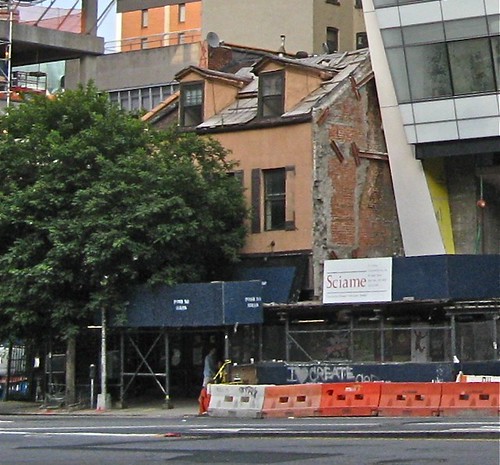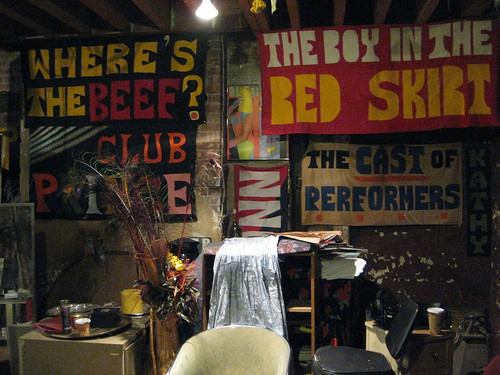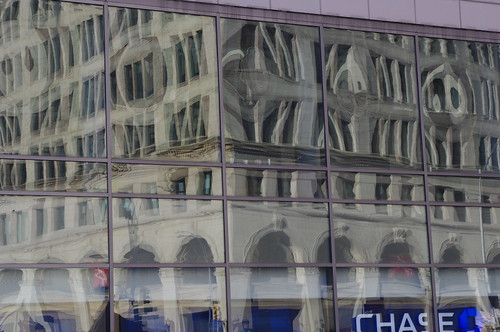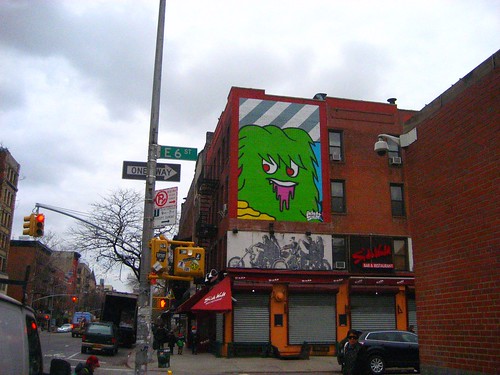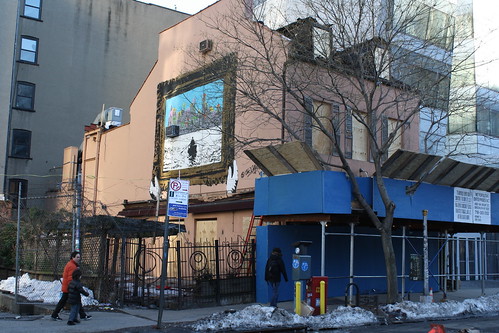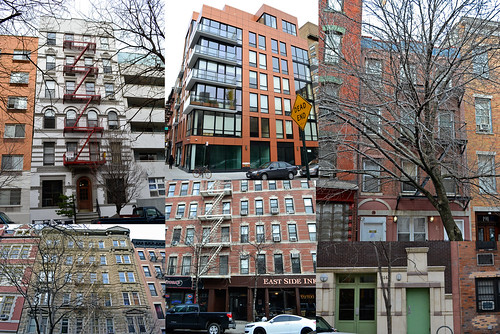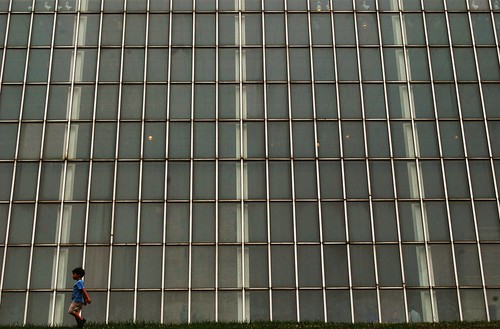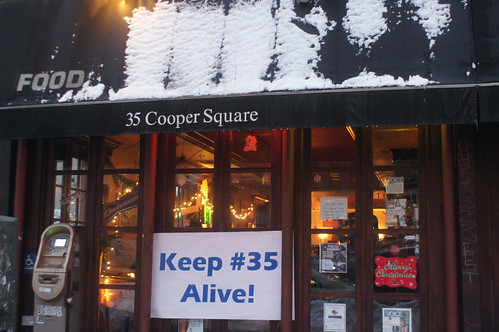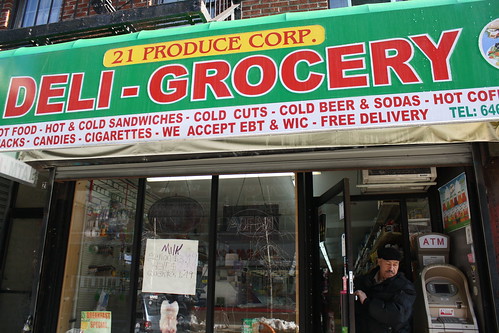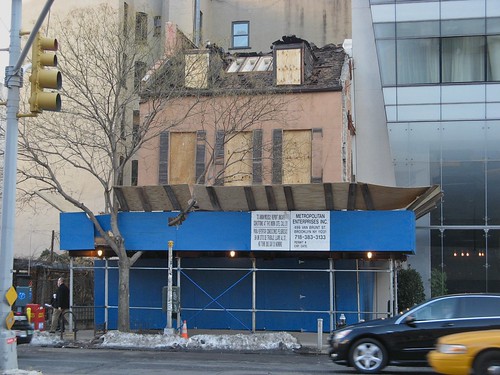Local Legends | 35 Cooper Square
By TIM MILK Clockwise from top left: (1.) Bowery Elevated Train, circa 1896; (2.) Bowery near Bleecker, circa 1915; (3.) 35 Cooper Square in February this year; (4.) Boys on the Bowery selling chewing gum, 1910; (5.) A Union enlistee of the New York 86th Regiment and his betrothed, circa 1861. All images courtesy Library of Congress, except (3.) lower right, photo illustration by Tim Milk
Clockwise from top left: (1.) Bowery Elevated Train, circa 1896; (2.) Bowery near Bleecker, circa 1915; (3.) 35 Cooper Square in February this year; (4.) Boys on the Bowery selling chewing gum, 1910; (5.) A Union enlistee of the New York 86th Regiment and his betrothed, circa 1861. All images courtesy Library of Congress, except (3.) lower right, photo illustration by Tim MilkLocal historian Tim Milk recalls dark episodes which never quite extinguished the charm of 35 Cooper Square.
They could hardly believe the fellow, wanting to go back to his regiment. Especially considering what he had seen: the rout of the Union at the bloody battle of Bull Run. There, the heroic Lieutenant John S. Whyte, who had refused to leave his wounded commander, fell into Confederate hands. But in a recent prisoner of war exchange, he was returned home to his kith and kin in New York.
But he did not wish to retire with honors. Indeed, he was keen to “return to the fight,” he said.
And so his pals shook their heads and dragged him down to the Marshall House, a tavern at 391 Bowery, an address we know today as 35 Cooper Square. There they presented him with a sword and a sash in an affair both touching and festive. After a grand hurrah, the champagne flowed like a river long into that night of March the 21st, 1862.
This I found in the archives of the New York Times, in a curious walk down that ancient lane, the Bowery. From out of each door came someone with a tale to tell which, except for these old papers, and poor relics like 35 Cooper Square, would otherwise have vanished, lost in time.
“Time,” Stephen Hawking once said, “…whatever that is.” Even he doesn’t pretend to know. As the so-called future, it is but a mere concept. As the past, it holds everything that has ever happened, and leads all the way back to eternity. There it washes up on distant shores for no apparent reason, except perhaps for our return. Read more…
The Significance of 35 Cooper Square
By KERRI CULHANESince 2002, architectural historian Kerri Culhane has worked with Two Bridges Neighborhood Council to document the history of the neighborhoods of the Lower East Side. In December 2010 she and Two Bridges received the New York State Preservation Award for Outstanding National Register nomination for the Chinatown and Little Italy Historic District. She is currently writing the forthcoming Bowery Historic District nomination, sponsored by Two Bridges Neighborhood Council and Bowery Alliance of Neighbors.
Formerly 391 Bowery, 35 Cooper Square was built between 1825-27, as one of four houses developed on the land of Nicholas William Stuyvesant. Stuyvesant was a direct descendant of the Dutch West India Company’s last director-general, Petrus Stuyvesant.
The development pattern north of Houston (then called North Street) remained very rural until the early 19th century. In 1811, a plan to establish a street grid north of the haphazard jumble of streets below Houston was mapped by surveyor John Randel. Third Avenue, branching off of the Bowery, was not built until the early 1820s. Stuyvesant’s four buildings were among the first ever built on this new road — the Bowery spur of Third Avenue. The 35 Cooper Square site is, therefore, an artifact of the most significant urbanization effort of New York, which left us with the grid system that now blankets the island.
The modest brick house at 35 Cooper Square would have been typical of its period, two-and-one-half stories, with a generous attic under a “peaked” roof lit by a pair of dormers. The defining architectural characteristics of the urban Federal era rowhouse include the form, most commonly two-and-one-half to three-and-one-half stories; gambrel or side-gable roofs featuring single or paired dormers; Flemish bond brickwork; and simple stone lintels. My recent research has identified at least 26 buildings dating to the Federal period still standing on the Bowery, of which only 12, thanks to minimal alterations, still clearly represent the era. Read more…
Up at the Old Nuyorican
By CARY ABRAMSClimbing the rickety, makeshift stairway of the century old former tenement building on East Third Street that houses the Nuyorican Poets Café there was little to foretell the treasure trove Kim Davis and I would encounter. Daniel Gallant, executive director of the Nuyorican, explained that few know of the existence of the archives we were set to explore, and even fewer got to view this lofty realm as the Café has no certificate of occupancy for the top three floors of the building, which are not open to the public and are used strictly for storage. Daniel described how poet Miguel Algarín, and the Café’s other founders, had acquired the building from LaMama Theater creator Ellen Stewart in 1980 and established a venue where Lower East Side poets, playwrights and musicians could present their work.
After Daniel unlocked the padlock fastened to a small piece of plywood serving as a makeshift door leading to the third floor, we crouched to squeeze through the narrow entryway. As we ascended the stairs, the exposed brick walls were crowded with posters, paintings and costume designs from former productions held in the performance space occupying the first two floors of the building. Reaching the top of the stairs we entered a dimly lit, open loft space crammed in virtual disarray with a treasure trove of costumes crowded on racks, stage props, banners, posters and a vast collection of bric-a-brac accumulated over more than thirty years.
Costume designers have borrowed some of these period outfits for use in recent films. A large sign for one of the Nuyorican’s landmark productions, “Julius Caesar Set in Africa,” hung on the wall. As we wandered about the floor, it was difficult to appreciate everything. Exposed brick walls, fireplace mantles, thick wooden rafter beams were the only remains of the former railroad apartments that had existed in the building’s former tenement incarnation.
Dan regaled us with the history of numerous Nuyorican productions which had their sets and costumes created in this space. Tony Award winning playwright and actor Sarah Jones began her career with her first solo show, “Surface Transit” at the Nuyorican in 1998. She recently returned for a two week engagement after a Broadway run of “Bridge and Tunnel.” A sewing machine, paint cans, bolts of fabric, containers holding glitter, jars full of buttons, rolls of yarn and thread were evidence of the many hours that artists and writers like Sarah Jones “Bridge and Tunnel” and Miguel Piñero (“Short Eyes”) labored in the space. Read more…
Liquor License Opposed for Venue
By HADAS GOSHENThe State Liquor Authority Committee of Community Board 3 Monday night refused to endorse a liquor license for a proposed music and restaurant space on Avenue A. With the 4-3 vote, the committee turned aside a proposal to open a new Mexican restaurant and lounge at 34 Avenue A. The proposal had been submitted by several owners, including Phil Hartman, who owns Two Boots Pizza and a former venue, Mo Pitkin’s House of Satisfaction, and the music promoter Todd Patrick; the fate of the project is unclear. —Hadas Goshen
The Day | To Catch a Hipster
By CRYSTAL BELLGood morning, East Village.
The Upright Citizens Brigade are gearing up to make their debut in the East Village by putting signs up around local mailboxes, reports EV Grieve. The comedy theatre troupe recently caused a stir among some locals with their “Hot Chicks Room” sign, located at the Upright Citizens Brigade HQ on Avenue A and Third Street. The sign refers to one of the brigade’s comedy skits. However, one local has started a petition to have the sign removed.
In other news, more artists seem to be leaving their mark in the East Village. Not only are there more manuscript pages handing on lampposts, but locals have also spotted finger sculptures protruding from posts. So far EV Grieve reports sightings on 11th Street, between First Avenue and Avenue A, and on 10th Street, between Avenues A and B. Have you seen any in the East Village? Tweet us your pics if you see any today.
Another piece, referred to as The Hipster Trap, was spotted on the corner of Avenue A and Sixth Street. An unknown artist baited a steel-jaw trap trap made of cardboard with a can of Pabst Blue Ribbon, a pack of American Spirit cigarettes, a bike chain and neon pink Wayfarers. The person who made the trap has yet to be identified.
As for the weather, aside from the partly cloudy morning, it looks like today will be mostly sunny with a high of 49 degrees.
Your Voices | More on 35 Cooper
By THE LOCALComments have continued to stream into The Local about an opinion piece by NYU Journalism’s Greg Howard that questioned the value of preserving 35 Cooper Square.
A sampling of reactions from the weekend.
One reader, “archietexture,” wrote:
“Residents recognize that new development of dorms, luxury hotels and condos does not benefit them. But being made a symbol doesn’t mean that 35 Cooper is not historically significant. Its loss will be a tragedy, and a travesty of the Landmarks process.”
Defending the preservation of the building, “Eastvillagearts” said:
“I’m certainly not arguing for places to be frozen in time – that would be counter to the compelling power of NYC’s continuing relevance. But there are places that have been particularly important to communities that need to be preserved. There are people and organizations and businesses that helped make neighborhoods what they are today who should be helped to stay. And the truth is that continued diversity and eclecticism is part of what continues to attract new residents, visitors and investment. The irony is that the market is attracted to precisely what it tends to destroy – authenticity.”
Elliott Hurwitt considered the legacy of unchecked development:
“But the developers will leave behind an immeasurably impoverished urban environment, one with no cultural resonance whatever, regardless of what you say about the East Village harboring the next di Prima, Hendrix or Madonna. The first of these 3 could never find a haven there now, affordable urban space in NYC is OVER, so there will be no further undergrounds, no beatniks, etc., that ended a long time ago.”
“Carol from East 5th Street” said the restaurant that occupied site in recent years transcended being just a watering hole for students:
“It was much, much more to me, my family, friends and neighbors. For most Sundays since the restaurant reopened as Cooper 35 Asian Pub and for the years before when it was Dolphins, it was where we had Sunday dinner. It was where we had gatherings of family and friends for just about every important event such as birthdays, graduations, milestones in our lives.”
Another reader, J.T., offered support for Mr. Howard:
“I think this is a good editorial piece. You spoke your opinion and caused great hype, mostly negative. But I believe that is just an older generation who is not ready for change. They are mad at Generation Y who are experiencing this vast change in lifestyle from the previous generations, where history in not of great importance. Generation Y likes and has experienced much change, which the older generations just aren’t as apt about. Everyone has an opinion.”
Another reader, “Mose,” recalled the building’s history:
“these buildings are cultural treasures literally, physical manifestations of 350 years of stories set in the most remarkable place humans have ever co-existed. men and women walked through the door of 35 cooper who were on the bowery only a generation earlier and watched as washington rode by. i feel fortunate to live in a place where i get to walk past these time capsules daily, history becomes tactile and experiential. ”
To Buy or Not to Buy?
By MARK RIFFEEIt’s fun to gawk at the $3 million lofts and $4 million townhouses in Curbed’s Marketplacelistings for the East Village. Most of us can’t do much more than gawk at these palatial 3,500-square-footers unless we’re feeling very ambitious and chance a pipe dream while lying in our beds — which are conveniently five steps from the kitchen, bath, and front door in our 450-square-foot studios — wondering if today is a hot-water day or no-hot-water day.
But maybe someday we will be able to afford a less garish apartment with a more reasonable price tag. In fact, if you have the money now or in the next few years, you may want to think about making a move sooner than later. According to Tara-Nicholle Nelson, consumer educator for Trulia.com, a real estate search engine company and research group, prices and interest rates are extremely low right now and qualifying for loans will become more difficult in coming years.
We at The Local asked Ms. Nelson for a status update on the East Village market and some expert advice on buying and selling.
How has the East Village market evolved recently?
In terms of price, we’ve seen value increase over this past year. On a price per square footage basis, there’s been a 26.5 percent year-over-year increase to $1,087 per square foot from $798 per square foot.
Read more…
Looking Back | 20 St. Marks Place
By RACHEL SLAFFThis post was reported by NYU Journalism’s Rachel Slaff, Todd Olmstead and Nasry Esmat. It was written by Ms. Slaff.
Yoga studios. Frozen yogurt stores. Tattoo parlors. Knock-off Ray-Bans, colorful socks and bubble tea – all for sale. Tourists swarm by pizza shops; college students flick cigarette butts onto the street. It’s loud, it’s crowded. It’s every possible cliche of the East Village, packed onto a block. This is St. Marks Place.
But fast food and neon lights haven’t always epitomized this street. Building No. 20, between Second and Third Avenues, has seen St. Marks Place change drastically over more than two centuries. This rowhouse traces its lineage back to wealthy descendants of the Stuyvesants, yet it also watched Warhol cavort through the Village. It witnessed the aftershock of a horrific peacetime maritime disaster. It has been home to soldiers and storeowners and has housed a dress shop, a carpentry workshop and a record store. No. 20 is a historical hold-out, an architectural remnant of times long forgotten in the East Village.
The metal plaque from the New York Community Trust that is affixed to No. 20’s facade notes that the address has landmark status for its late-Federal style architecture. But the ornament is not large or flashy enough to draw much attention – it is as if the building wants to be left alone. The plain signs of the businesses on its first two floors are a muted counterpoint to the sensory overload that the rest of the block exudes. The building’s iron railing is decrepit, its brick facade unremarkable, and yet, the limestone molding on the door hints at a meaningful history.
Read more…
The Day | A Poet’s Passing
By CRYSTAL BELLGood morning, East Village.
We begin the week with some sad news. The East Village suffered a loss this weekend when Ricardo León Peña Villa, the Colombian-born poet known as El Poe, died Friday at Beth Israel Hospital after being in the intensive care unit for the last few weeks. According to EV Grieve, there’s a small memorial set up for El Poe, honoring his memory, outside the Umbrella House on Avenue C where he had not only lived but also helped manage the building with other tenants.
In other neighborhood news, Tompkins Square Park will welcome a new permanent fixture this weekend – a ping-pong table. DNAInfo reports that the table will arrive on March 19, and be placed between the park’s flagpole and center lawn. And if you’re worried about a little rain and wind getting in the way of your table tennis match, the table will reportedly be made of polished concrete and will include a steel net, so players can compete no matter the conditions.
Amid the continuing debate about preserving historical buildings in the neighborhood such as 35 Cooper Square, The Local today will begin a new occasional feature that describes the histories of neighborhood buildings, both well-known and anonymous.
As for the weather, expect a partly cloudy day with a high of 48 degrees.
Viewfinder | Tim Schreier
By TIM SCHREIERTim Schreier on finding his visual muse in New York City.
“New York City has to be one of the greatest ‘canvases’ to practice photography; the neighborhoods, art, architecture, events and, of course, the people make this city and its neighborhoods a dream come true for a photographer. The ‘East Village’ and Lower East Side are truly unique places. The diversity of cultures in such a close proximity is my favorite element to this part of the city.”
Read more…
Your Voices | 35 Cooper Square
By THE LOCALFew posts that have been published on The Local have generated as much strong reader response as NYU Journalism’s Greg Howard’s opinion piece questioning the value of preserving the historic site at 35 Cooper Square.
Readers offered a range of opinions that touched on questions of the neighborhood’s authenticity, who is qualified to comment on community issues, and the frequent tensions that occur between the university and the community.
Commenters wondered if Mr. Howard’s age – he’s 22 – and relative short time in the neighborhood – he has been here all of eight months – diminished the credibility of his perspective. “You should have stopped at the part about being young, ignorant, and new to town,” Bryan wrote. “Just because NYU students don’t notice the unique elements of their surroundings doesn’t mean others are being insincere in their outrage.”
“East villager” wrote: “I hope for both society’s and your own sake as an individual that you will one day mature into the type of man who will be ashamed to have written and published such a thing as a callous and arrogant youth.”
Another reader, “your worst nightmare intellectually speaking,” offered an even more unvarnished appraisal:
“You disgust us. Get it?? You epitomize so much that is wrong with the fabric of NYC. You are another bloggong spokesman for a generation of unoriginal posers in every way. You make me want to vomit you arrogant out of town, know nothing, know it all- kid.”
Other readers argued for the importance of preserving historical sites. Someone “who actually likes New York” wrote:
“The city should protect its history, and 35 Cooper Street is a much more compelling example of it than the modernist towers the city has in droves. Quality of life, attractiveness of the city to workers and tourists, and diversity of retail all depend on small, historic buildings like this existing. It would be one thing if today’s architecture were half-decent. But, Thom Mayne blockbuster buildings aside, it’s primarily cheap and hideous.”
Lisa noted that:
“…when something like the African burial ground is re-discovered, for instance, that “newfound” history adds something back to the richness and diversity and curious experiment that is New York. The City immediately becomes a more interesting place. Wouldn’t it be nice to keep some of that intact, not only for ourselves, but for the New Yorkers of the future?”
“Snapped” added:
“Nothing worth having comes easy. And that goes the same twice over for boutique hotels and shreiking girls throwing up outside my building. Just because they can be here doesn’t mean it’s ok, or they should.”
“Calm down everyone” offered a defense of Mr. Howard:
“Is the juxtaposition that happens here now not fascinating? And my main question is, do the old time East Villagers really believe all the younger people who’ve moved here are bad? HELLO, culture moves in waves, there’s a new one happening… that’s not stopping, that shouldn’t be stopped. Embrace it, I think I’m finding out new things about myself daily. Keep writing Greg.”
Join the conversation: Do the ever-replenishing supply of newcomers and transient residents in the East Village have a right to speak on neighborhood issues ?
At Degustation, Food with a Flourish
By JAMES TRAUBAt Degustation, a tapas restaurant at 239 East Fifth Street, the indispensable article in the chef’s toolkit is the tweezers. The dishes are of micro dimensions, and are arranged from their constituent elements with minute delicacy. Once my wife and I had settled ourselves at one of the short ends of Degustation’s 16-seat U-shaped counter, we watched Oscar Islas, a burly chef, remove from a small plastic tub a tiny, soft pumpkin-colored object and delicately place it inside a ceramic egg cup. Oscar then put down his tweezers, and with a small spoon scooped a flimsy white blob of something unrecognizable into the cup — a panna cotta which had just enough gelatin content to prevent it from deliquescing altogether.
“What’s that?” my wife, Buffy, asked in horror. “That is way too wiggly for me to eat.” Yara Oren, who works next to Oscar and does more of the talking, explained that it was the sea urchin we had just ordered. “I promise you,” Yara said, “you will love it.” The tiny white-orange mass in our cup lay in a mild broth. I devoured most of the sea urchin and passed it to my wife, thus slightly reducing the ick factor. “Whoa!” Buffy said. “This is fantastic.”
Pretty much everything produced under the supervision of Degustation’s head chef, Wesley Genovart, is fantastic, both in the sense of wonderful and of pressing against the borders of conventional reality. It is the East Village’s window into avant-garde Spanish cuisine. The act of assemblage is as essential to such cuisine as the chemical transformation involved in cooking. An actual cook’s station runs along the length of Degustation’s counter, with a gas grill and burners, and Oscar and Yana performed their magic on the plates of grilled fish and meat being prepared behind their backs. The cooking seemed almost banal by comparison. If you’re seated at either end, you can witness the delicate compositional flourishes from two feet away. If you’re seated along the length of the counter you’ll have to make do with the gross business of applying heat to raw flesh.
Read more…
For Bodegas, An Uncertain Future
By AMANDA PLASENCIA and CLAIRE GLASSMexican music recently filled the 21 Produce Corp. Deli and Grocery on Avenue B near Second Street in the East Village. But on a recent Thursday afternoon there was no one in the store to buy the corn tortillas, cigarettes and other staples of this corner bodega.
“We’re already losing a lot of businesses due to increases in rent and if it keeps going on like this, we won’t be in business much longer,” Geodoro Hernandez, 55, who works the counter at 21 Produce Corp., said as he gazed around the empty store.
The desolate scene at 21 Produce is a stark example of how small, neighborhood grocery and convenience stores are struggling to stay afloat in a rough economy. Retail groups and other industry experts say that a combination of forces, including high rents and competition from larger, more upscale markets, have placed the future of many bodegas in jeopardy.
In a recent survey of the city’s bodega owners, roughly half said that their businesses are at risk of closing. The cause? Nearly three-quarters cited rising rents.
Read more…
The Day | More Support for 35 Cooper
By KATHRYN KATTALIAGood morning, East Village.
After being slated for almost certain demolition, 35 Cooper Square may live to see another day. Our friends at Bowery Boogie bring us news that neighborhood preservationists received support last night from Community Board 3, which voted to send a resolution to site developers outlining the community’s desire to save the historic building.
Get your brackets ready—March Madness is officially underway. Whether you’re a die hard fan or casual follower of the NCAA, it’s hard not to get swept up in the thrill of good competition. New York MetroMix suggests heading over to Professor Thoms or the Village Pourhouse to catch a game or two. We want to know—where will you be watching?
From slam dunks to slam downs, the Nuyorican Poets Cafe is housing a showdown of a different sort this weekend as aspiring young writers and lyricists go head to head to compete in Urban Word’s NYC Teen Poetry Slam. Come see the action yourself on Saturday.
EVGrieve reports a smash up between a taxi and a pickup truck yesterday on Second Avenue, and DNAInfo tells us not to expect any food vendors to come to Cooper Square Park anytime soon.
Expect this morning’s rain to give way to sunny skies later this weekend. Today’s temperature should climb up to 55 degrees.
East Village Tweets
By BRENDAN BERNHARDWould-be messages from the East Village, in 140 characters or less.
Sunday Morning on Avenue C
The joy of it the sting of it the bells of it the glare of it
the birds of it the eyes of it the prayers of it the drugs of
it the it of it
Sidewalk Encounter
The rat crossed his path with such nonchalance the damn
thing might as well have been wearing shades &
smoking a bidi
The British Lawyer
…Surveyed our sunken roofs, loose bricks, black
spaghetti of dangling phone wires, & declared, “In
London, this would all be illegal!”
Personal Trainer
I met it at downtown’s trendiest gym
could never ascertain: her or him?
never saw it change or shower or swim…
but now I’m toned and trim
P.S. 122
Should artistes shovel snow like normal people? Please.
Pratfalls are aesthetic (Tati, etc.), and black ice is a
frozen film noir…
Middle Age (Paging Lou Reed)
O it’s such a perfect day (though I barely slept) I’m so
glad I spent it with you (whoever you are) where is the
damn zoo, anyway?
Disappointment
At the Immaculate Conception Church, the priest offers
bread, but no wine. The blood of Christ is available only
on Sundays
Beautiful Girl at the Nail Salon
She worked in TV and sounded like TV so he pretended
she was TV and returned his gaze to the mute black hair
of the Asian woman at his feet
Tech-Tock
Even when you refuse to believe them, memes can cling
like cellophane: This bookstore is a dying thing,
empty an hour before closing
Lunch Date
The Loneliest Man in the East Village took the Second
Loneliest Man to lunch. They ate mostly in the silence of
silverware. Both agreed
that they were failures, that their erotic prospects were
risible, that their Linked-In profiles were musty tombs,
and that they rarely met
anyone not connected to the service industry except in
movies, books, and dreams
Discuss
The fact people can be left to die on the sidewalk has
always made the East Village viscerally exciting to
young Europeans
Conversation | 35 Cooper Square
By GREG HOWARDAs we know by now, the 185-year-old 35 Cooper Square is about to be torn to the ground, and replaced by a giant futuristic hotel, or luxury condominiums, or a really swanky office building, or some such non-East Village-y thing. And as we know by now, a lot of longtime East Villagers aren’t happy about it, the destruction of the awe-inspiring, historical, super-significant ageless wonder that was the Asian Pub.
Protestors picketed, petitions were signed, letters were mailed, and for naught. The capitalistic Man that is New York City prevailed. It’s a time for tears, right?
Not so fast. Recently, one of The Local’s readers commented on the expected demolition of the historic building, saying that even though she went to school and lived closed by, she “didn’t even know it existed.”
And although I’m but 22 years old, only lived in the East Village for some eight months, and am more privy to this neighborhood’s prolific bar scene than its historic past, I can’t help but thinking that maybe, just maybe, this sudden preservationist uproar is a bit, well, contrived.
Because as I said, I don’t know much about this neighborhood. I do know, though, that for years, 35 Cooper Square was little more than a place for broke NYU and Cooper Union kids to get really, really drunk. It was a lovely place, but not really historic. Where was the outcry then?
The days of Diane di Prima living upstairs have long since passed. Over time, 35 Cooper Square evolved, from a residential haven for poets and writers, to – like it or not – a cheap watering hole. Over time, 35 Cooper Square’s become little more than an eyesore next to its surroundings. And somewhere over that time, 35 Cooper Square lost its history.
One preservationist said to me in disgust that by the time the Bowery is fully developed, “only the wealthy and trust fund babies” would live here. Her anger seemed less directed toward 35 Cooper’s demise and more at the type of people who will ultimately live here.
But why are we fighting it? This is one of the most progressive neighborhoods in one of the most progressive cities in the world. For decades, we’ve been a haven for artists, musicians, minorities, gays, freedom fighters, beatniks, hippies. Our rich history stems from us opening our doors, to everyone, and the ever-shifting landscape that our tolerance produces.
The East Village skyline will shift, and shift again. It always has. Who’s to say this is a bad thing, or that tomorrow’s residents won’t include the next di Prima, Hendrix, or Madonna? As East Villagers, it’s our duty to remember the past. But when we reflexively cling to our past, when we use 35 Cooper Square as a scapegoat for fear and uncertainty of an unseen future, we become something altogether different.
Join the conversation: Is the concern over preserving 35 Cooper Square justified?
Locals | Fabio Clemente
By MARK RIFFEE and GREG HOWARDFabio Clemente has been an East Village mainstay since he opened the Alliance Brazilian Jiu Jitsu studio nine years ago at 13th Street and Third Avenue. A single father of two and a second-generation jiu jitsu black belt, Mr. Clemente, who’s 45, dreams of one day spreading the art of jiu jitsu through the Americas with his promising son, Zata, 17, at his side.
NYU Journalism’s Mark Riffee and Greg Howard report.





